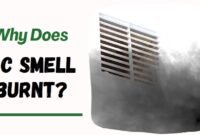Air Conditioner Leaks Water Outside
Seeing your air conditioner leaks water outside could either be a significant issue or just a normally functioning system. Even worse, this situation might appear at any given time, so knowing how to deal with it is crucial.
A window air conditioner unit has to double the work to cool the room down in humid weather. This often affects the window air conditioner leaking water outside. In this case, a leaking air conditioner shows that the system is well-functioned and the water will dry up.
Each window air conditioner unit comes with a dew point temperature. When the unit has reached its highest level of humidity and can’t hold the moisture any longer, the dew point will produce condensation. This situation causes the unit to form water drippings.
The water that runs down should be flowing through the small holes on the base plate and partially evaporated by the heat outside. However, you can detect a severe problem if the leakage won’t disappear within days. With the temperature levels constantly changing, you still see the water underneath your air conditioner.
So, if this happens to you, what should you do to fix your unit?
Lucky you, we will break down the solutions for window air conditioner leaking water outside. Let’s keep on reading!
How to Fix Air Conditioner Leaking Water Outside
To find the best solution for your window air conditioner leaking water outside only means finding the reasons behind it. You should know several causes and how to fix with each.
- Clean Your Dirty Air Filter
As petty as it sounds, poor maintenance of air filters results in a leaking air conditioner unit. The amount of dust inside your unit will block off the system completely. Once it’s blocked, the unit won’t blow the cooling air and freeze up the evaporator coils. In conclusion, the excess water will constantly drip from the drain pan.

It’s best to clean your air conditioner at least once in 30 days. You can clean the filter easily by using a vacuum cleaner for those little dust. You can also do an easy hack with a mixture of white vinegar and warm water. For a deep clean of layers of dust, we recommend you to contact an AC technician.
- Incorrect Ways When Installing The Air Conditioner
Look back and rewind. Did you install the air conditioner properly? The window air conditioner that keeps leaking water could be a cause of a gap between the front end of the unit and the back end of the unit. If you didn’t set the front one an inch higher, chances are you create a pool of leakage.
In this case, an air conditioner professional will help you to reinstall your unit correctly. If you don’t want to spend an extra penny, make sure to reinstall it safely. Keep in mind that you must put the two ends in an inch difference.
- Cracks on The Drain Pan
An air conditioner comes with a drain pan that is supposed to catch the water dripping when the system is on. If it’s damaged, it will stream down around the edges. This is one of the common reasons that your air conditioner leaks water outside.
The cracks of a broken drain pan tend to be tiny. It’s suggested to locate them with a flashlight while touching them. To repair this, you can do a simple DIY hack using epoxy though it’s not a one hundred sure. If you got extra cash in your pocket, then replacing the pan with a new one is the most innovative way to avoid any other leakage in the future.
On a final note, drippings of water from the air conditioning unit are a sign of a normally functioning unit. Somehow, it could be a sign of damage if the water starts pooling around.
That’s the time when you must pay attention to how your air conditioner leaks water outside as it will determine its solution. So, do you find these tips helpful? Let us know!


